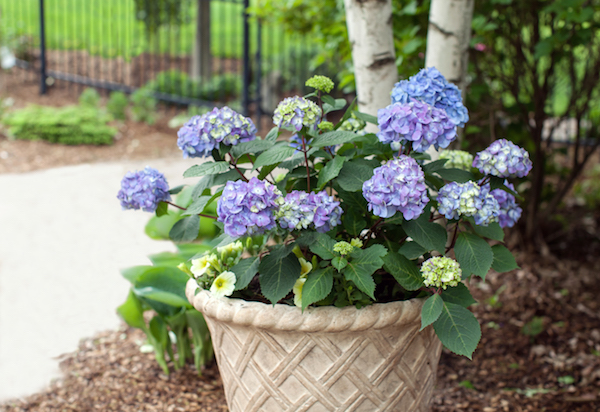
Bloomstruck hydrangeas were among 75 plants Bailey Nurseries donated recently to the Indianapolis Museum of Art.
Photo courtesy Irvin Etienne
Endless Summer may be the best selling series of hydrangeas, but they frequently come with a lot of questions, with the main one being “why won’t my plants bloom?”
For answers, I went to the source.
Ryan McEnaney is a public relations and communications specialist at Bailey Nurseries in St. Paul, Minnesota. He’s a third generation member of the Bailey family, which has been breeding and selling plants for nearly 120 years. Bailey introduced Endless Summer hydrangeas in 2004, marketing them as rebloomers. For gardeners, that translates into flowers all summer long.
With perhaps a slight smile, he suggested mulching Endless Summer hydrangeas 6 to 12 inches of chopped leaves to protect them through winter. The flower buds, which are formed late in summer for the following year’s blooms, frequently get frozen when temperatures take a dip in spring. The mulch protects the plants from that danger. “But who is going to do that,” I asked? We both laughed and agreed not very many of us.

Bloomstruck’s long season of flowers makes it perfect for a summer container on the porch, patio or balcony, or as a focal point in the garden. Photo courtesy Bailey Nurseries
Reblooming hydrangeas bloom in early summer on stems that wintered over and then later on current season growth to provide flowers all summer. Whatever you do, don’t prune them until the plants have leafed out fully in spring. And then remove stems that have not leafed out or cut them back to where there are green leaves, he said.
“Don’t over fertilize them, which just encourages green growth,” he said. “Fertilize once in spring and if you think it’s needed, in summer.”
He said Bailey’s newer introduction of BloomStruck has hardier flower buds, which makes them handle winter better. Other tips: plant them in a partly shady location and water regularly.
McEnaney was in town recently to donate 75 woody plants, including Bailey’s Endless Summer BloomStruck hydrangeas (H. macrophylla), to the Indianapolis Museum of Art. Also in the mix were Bailey’s First Editions’ Jetstream oakleaf hydrangea (H. quercifolia) and Summer Cascade wisteria (W. macrostachya), two new cultivars of native plants.
Irvin Etienne, horticultural display coordinator at the IMA, said Bailey’s donation allows the museum to try new plants in areas that need attention while freeing up the budget for other improvements.
Blue or pink big leaf hydrangeas?
Big-leaf hydrangeas (H. macrophylla), such as BloomStruck, Let’s Dance and many others, will have pink flowers in Indiana and other Midwestern gardens, because our soil tends to be alkaline (high pH). An acidic soil (low pH) is what turns the flower color into the blue range. Here are some more tips.